Forums
- Forums
- Duggy's Reference Hangar
- USAAF / USN Library
- Douglas F3D Skyknight
Douglas F3D Skyknight
Post a reply
- Go to Previous topic
- Go to Next topic
- Go to Welcome
- Go to Introduce Yourself
- Go to General Discussion
- Go to Screenshots, Images and Videos
- Go to Off topic
- Go to Works in Progress
- Go to Skinning Tips / Tutorials
- Go to Skin Requests
- Go to IJAAF Library
- Go to Luftwaffe Library
- Go to RAF Library
- Go to USAAF / USN Library
- Go to Misc Library
- Go to The Ops Room
- Go to Made in Germany
- Go to Campaigns and Missions
- Go to Works in Progress
- Go to Juri's Air-Raid Shelter
- Go to Campaigns and Missions
- Go to Works in Progress
- Go to Skinpacks
- Go to External Projects Discussion
- Go to Books & Resources
-
 Main AdminText by Greg Goebel as always thanks.
Main AdminText by Greg Goebel as always thanks.
The Douglas Skyknight was one of the first purpose-built jet night fighters; it served with distinction in the Korean War, and survived to put in useful service in the Vietnam War as well. This document provides a history and description of the Skyknight.
ORIGINS: XF3D-1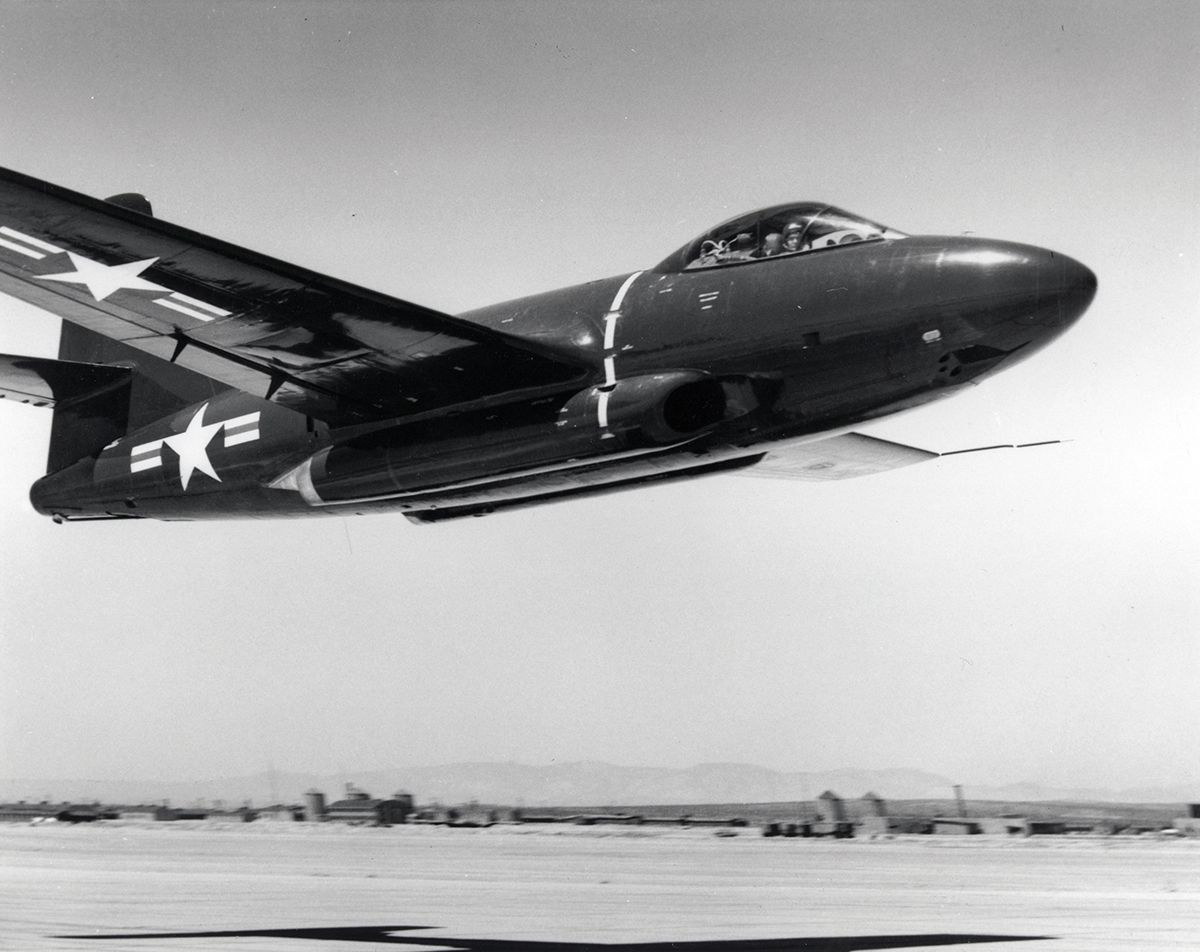
In 1945, the US Navy began studies for a jet-powered carrier-based night fighter, resulting in issue of a request specifying a two-seat aircraft with long range radar and good performance. Douglas, Grumman, Curtiss, and Fleetwings submitted proposals, with Douglas awarded a contract on 3 April 1946 for delivery of three prototypes with the designation "XF3D-1 Skyknight". Notice the spelling was "Sky-Knight", not "Sky-Night".
Development was conducted by a team under the well-known Ed Heinemann at the Douglas division in El Segundo, California. The first prototype XF3D-1 made its initial flight on 23 March 1948, with test pilot Russell Thaw at the controls. All three prototypes were sent to Edwards Air Force Base in October 1948 for service trials. The Air Force was interested in the Skyknight for a time, since the Northrop F-89 Scorpion all-weather interceptor was suffering from development problems, but the USAF decided to acquire the Lockheed F-94 Starfire interceptor, a derivative of the Lockheed T-33 trainer, as an interim solution until the Scorpion's bugs were ironed out.
The Skyknight was of simple configuration, with:
Mid-mounted straight wings that folded vertically from the midsection.
A conventional tail arrangement.
Tricycle landing gear, with single wheels on all gear assemblies, the main gear retracting outward into the wings, and the nose gear retracting backwards.
A stinger-type arresting hook.
A skid with a tiny wheel on the end was mounted in front of the arresting hook, and could be extended to protect the aircraft from bumping its tail on takeoffs and landings. A hydraulically operated air brake was mounted on each side of the fuselage behind the wings.
The Skyknight was powered by twin Westinghouse J34-WE-22 turbojets with 13.3 kN (1,360 kgp / 3,000 lbf) thrust each, fitted in nacelles mounted low on the fuselage below the wings. The engines could be easily accessed for maintenance, and dropping them out for replacement was a simple procedure. However, it seems likely that the low position of the intakes made the aircraft vulnerable to runway foreign object ingestion. The aircraft was armed with four 20-millimeter cannon mounted in the underside of the nose, with 200 rounds per gun. Internal fuel capacity was 5,116 liters (1,350 US gallons). A 568-liter (150 US gallon) external tank or a 450 kilogram (1,000 pound) bomb could be carried under each wing.
The pilot and radar operator sat in a side-by-side configuration. The ejection seats available at the time could not work safely with such a seating arrangement, and an unusual escape mechanism was designed involving a chute in the floor behind the flight crew. Pulling a lever would blow off the rear half of the chute exit hatch in the belly between the engines, with the front half serving as a windbreak. Each crew member would then pivot around in his seat, grab a vaulting bar behind the seat, kick open a cockpit exit door, and slide out the chute feet-first, one crew member at a time. It wasn't a real ejection system, but it was better than nothing.
Westinghouse AN/APQ-35 radar system was fitted in the nose. The first two prototypes had been fitted with the older SCR-720 radar since the AN/APQ-35 hadn't been available at the time. The AN/APQ-35 actually consisted of two radars:
The AN/APS-21 search radar, which could locate fighter-size targets at a range of 32 kilometers (20 miles).
The AN/APS-26 targeting radar, with a range of 3.2 kilometers (2 miles).
The AN/APS-21 could be used to locate a target, pass it over to the AN/APS-26 at close range for target tracking, and continue to scan for new targets. It was one of the first "track while scan" radar systems ever developed. Reliability was not the best, but that was true for all complicated avionics systems of the era.
The prototype evaluation was successful, and led to an initial production order for 28 "F3D-1" Skyknights in June 1948. The first production F3D-1 flew on 13 February 1950, and the type went into operational service with the Navy VC-3 Squadron at Moffett Field, California, in December 1950.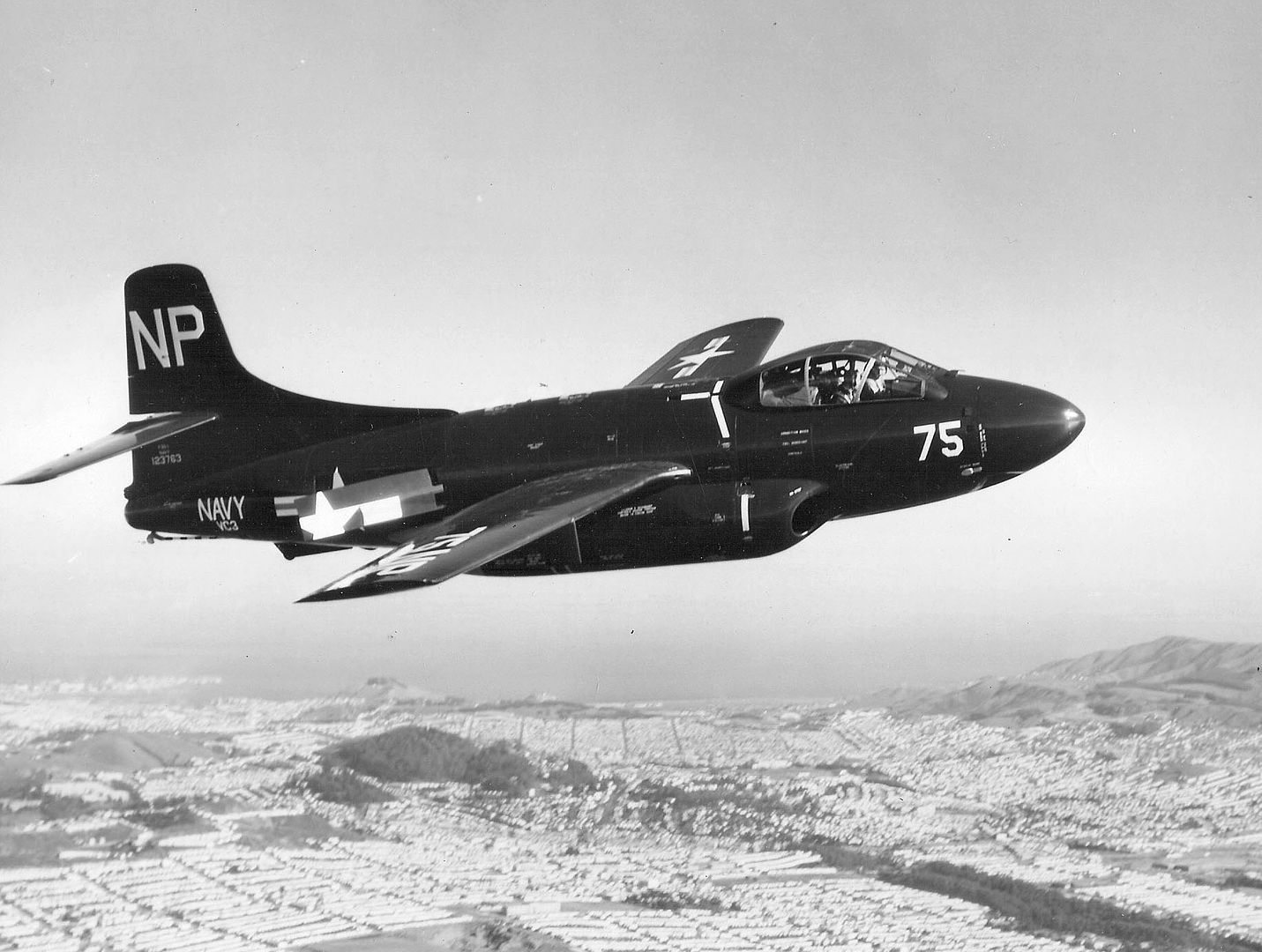
F3D-1 / F3D-2 / KOREA
The F3D-1's airframe was similar to that of the XF3D-1, but it was fitted with a stronger tail bumper wheel, and fully operational electronic systems that increased the takeoff weight by over two tonnes. It also featured uprated Westinghouse J34-WE-34 engines with 14.5 kN (1,475 kgp / 3,250 lbf) thrust each, the new engines requiring larger nacelles. A few early production F3D-1s were not fitted with the uprated powerplants due to engine non-availability.
The F3D-1 was still definitely underpowered, and only the initial batch of 28 were produced. The F3D-1s remained stateside and were used for training flight crew for the definitive Skyknight variant, the "F3D-2".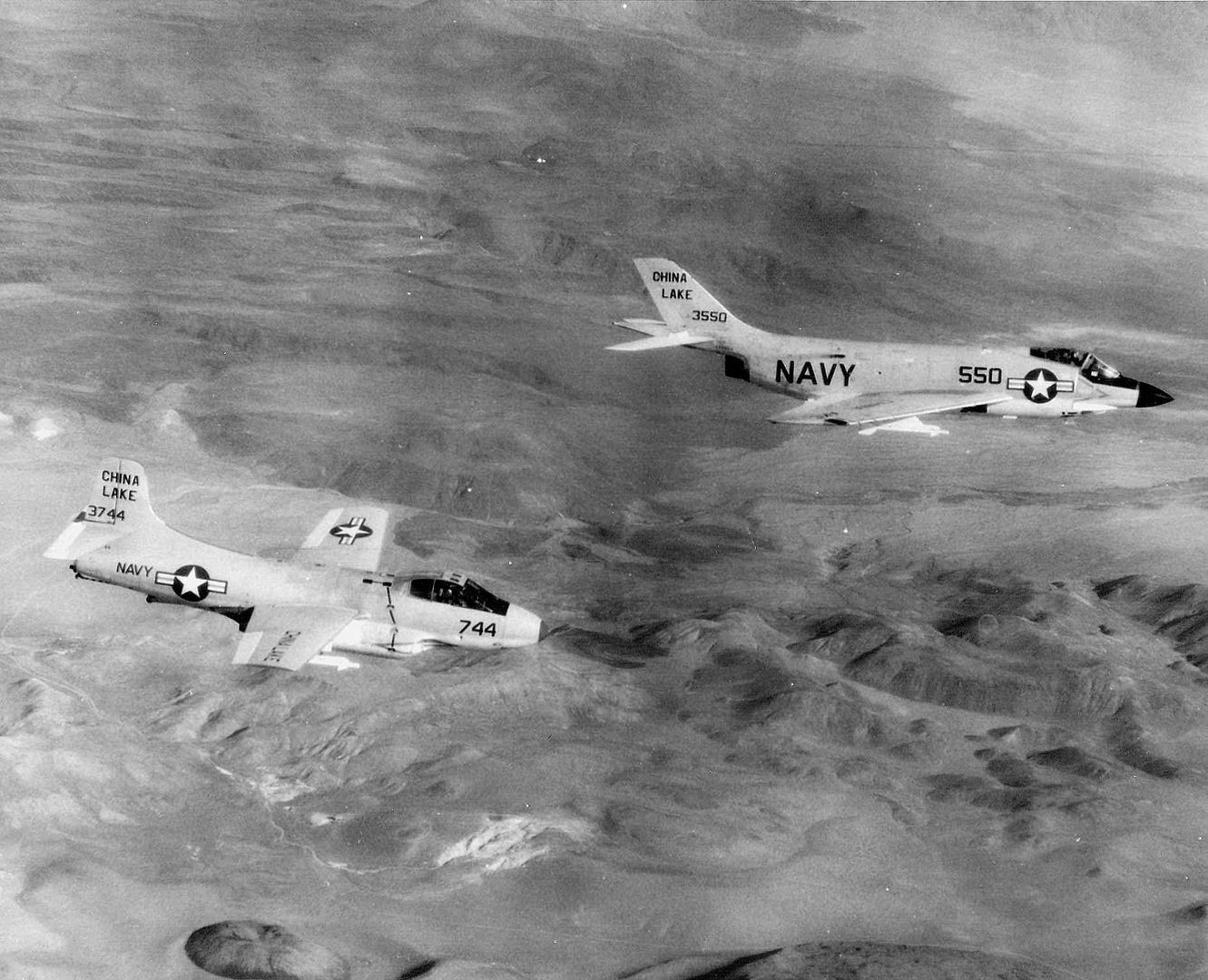
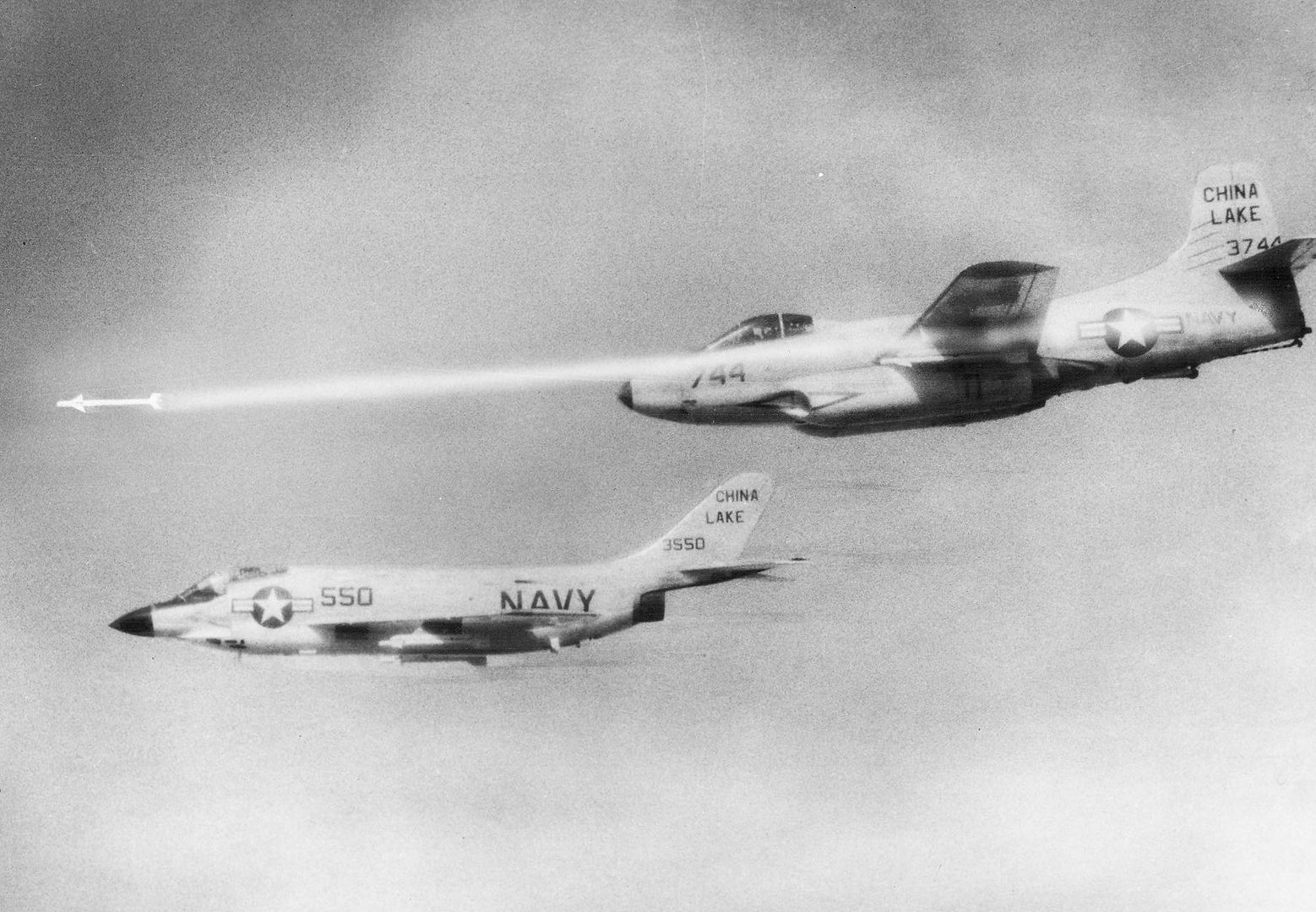
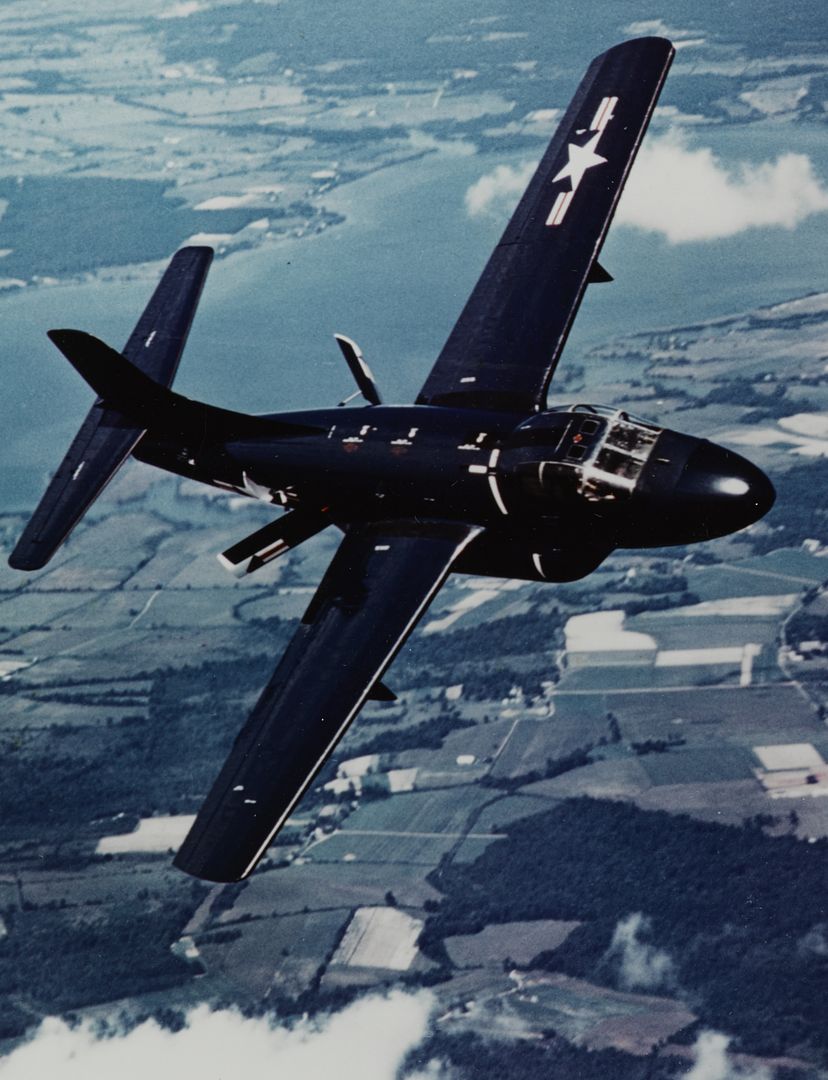
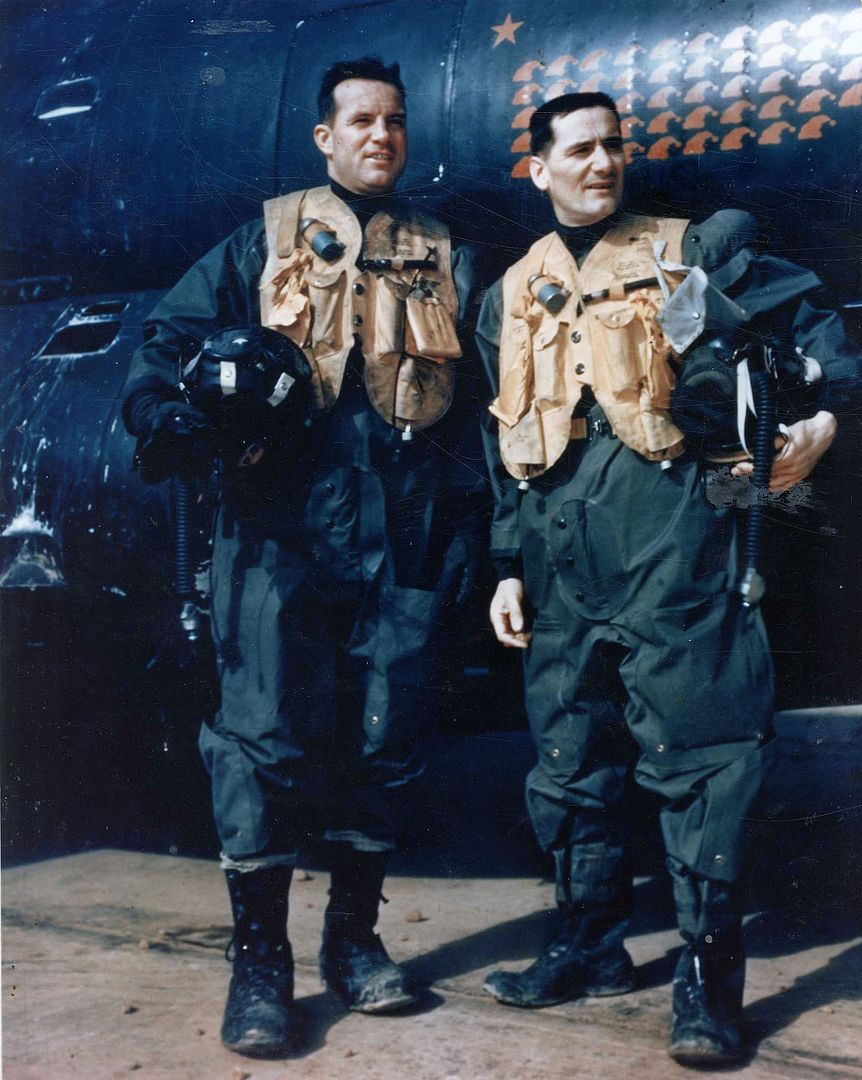

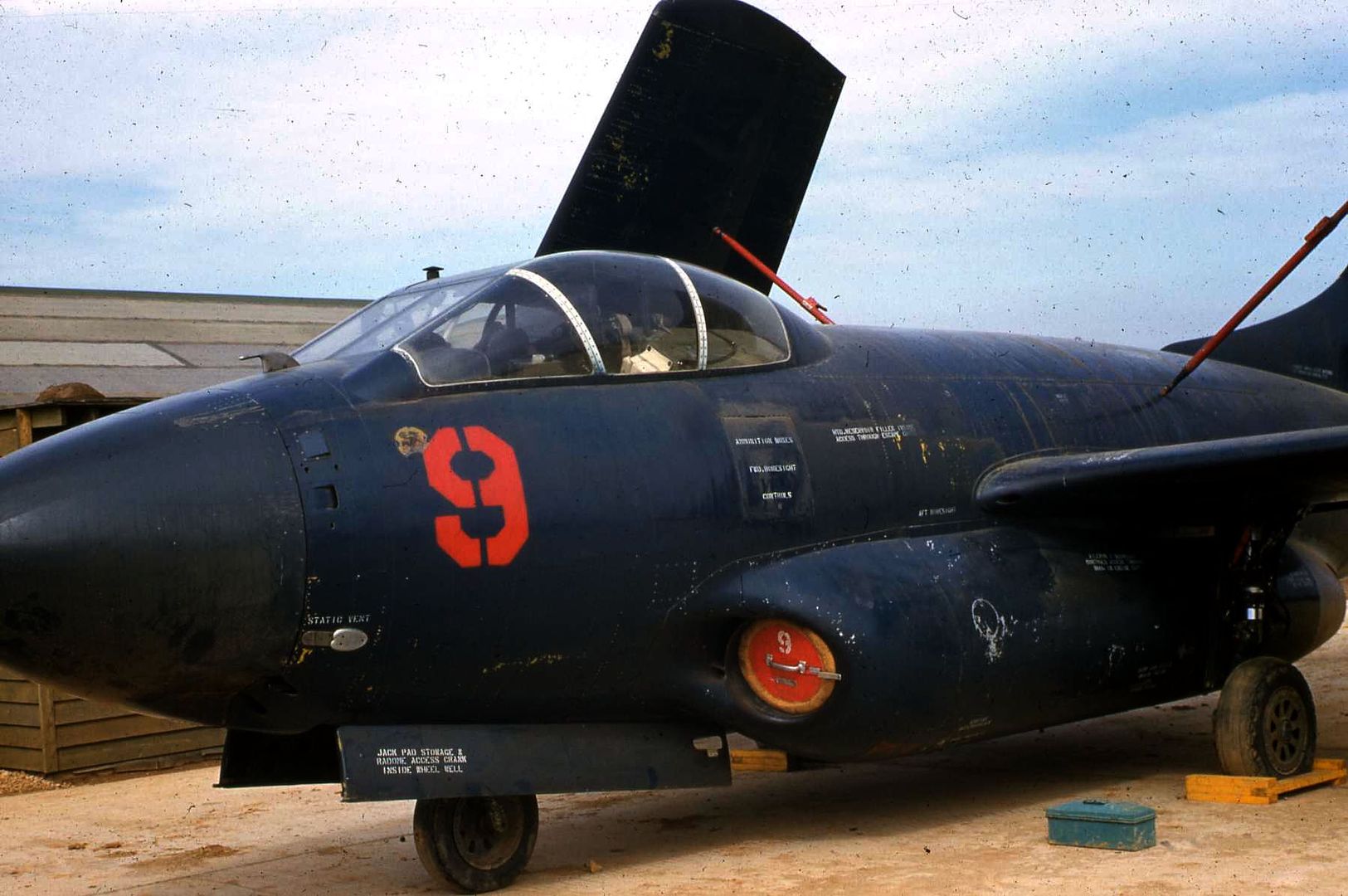
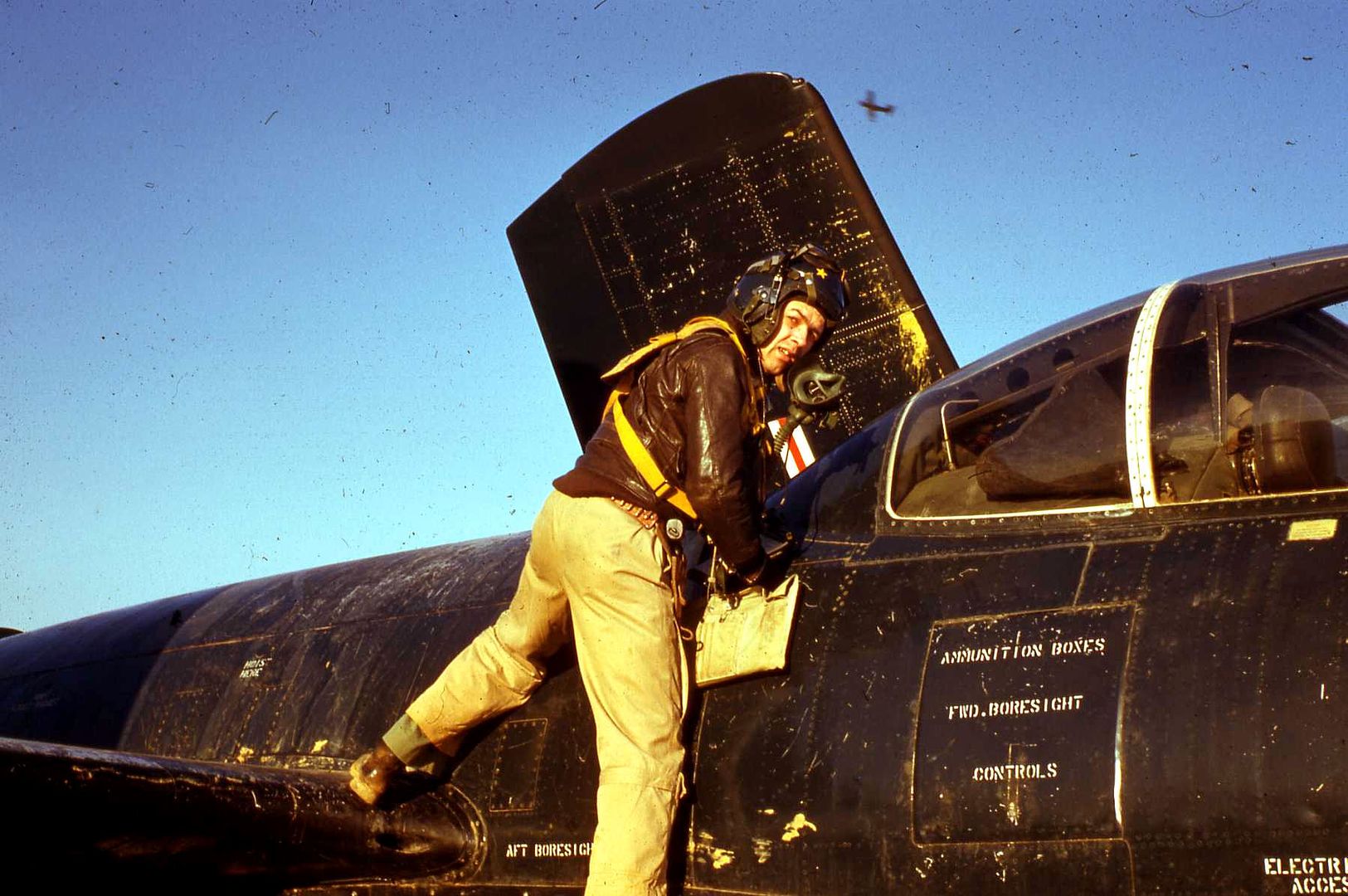

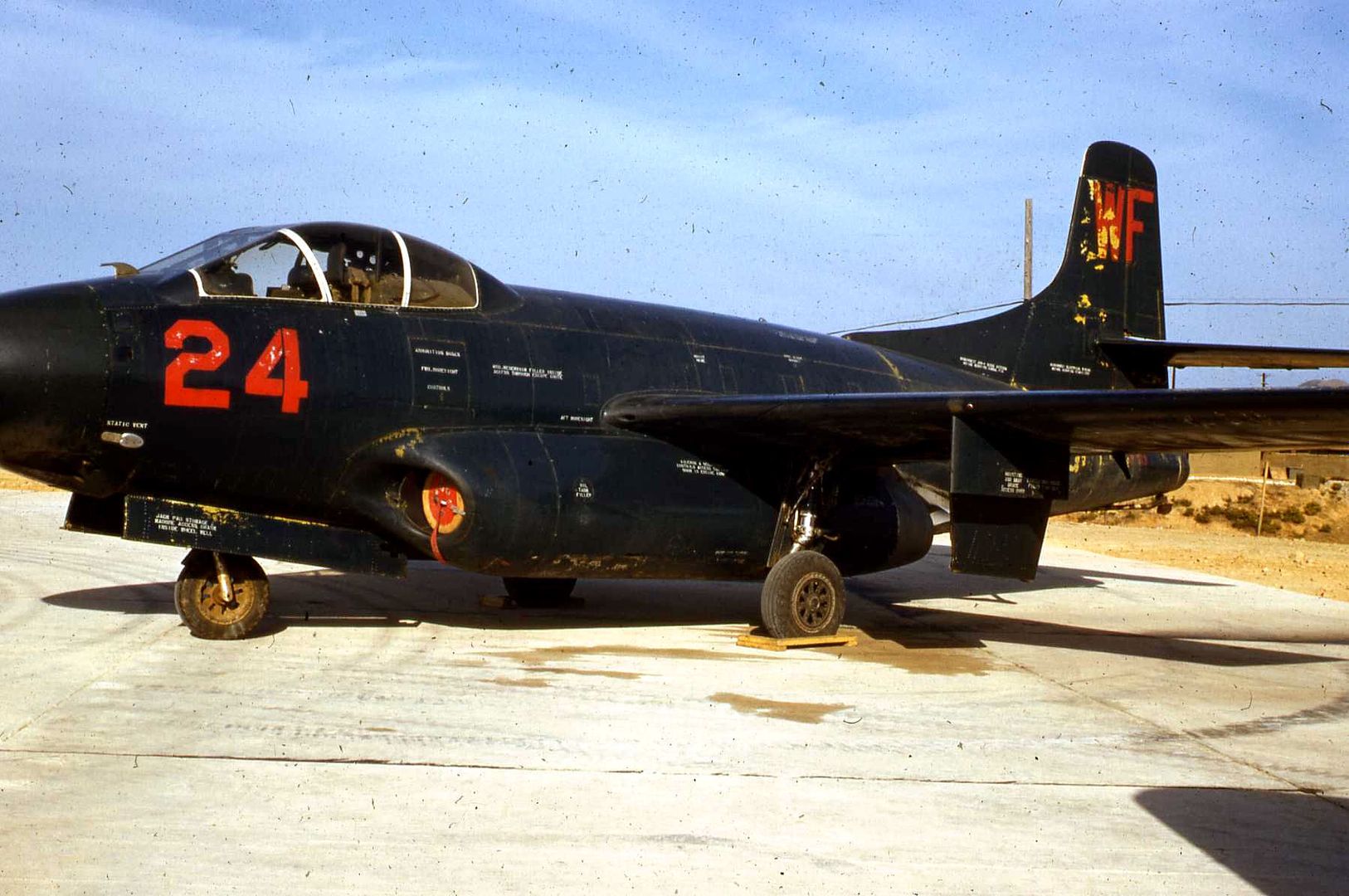
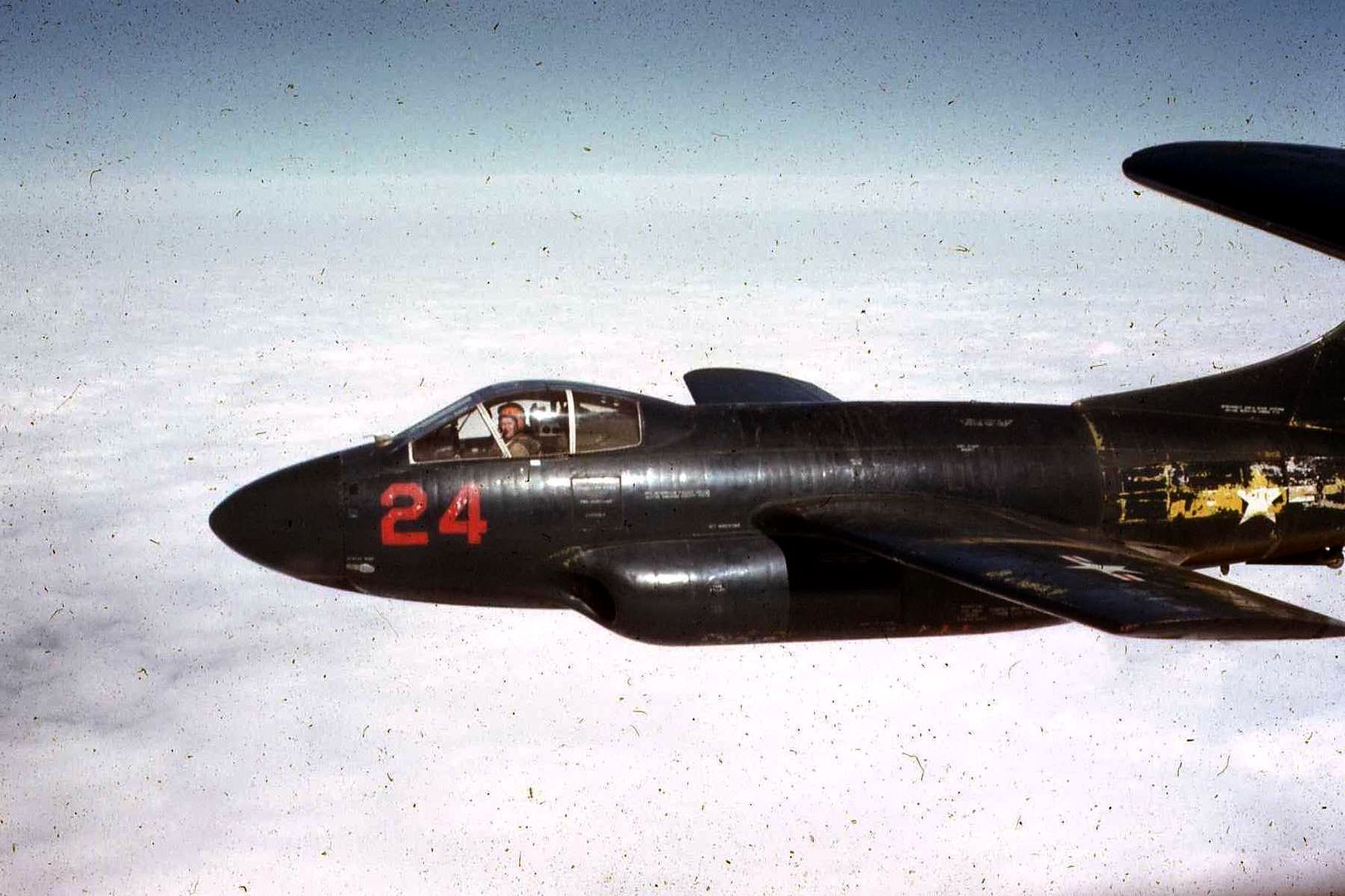
The F3D-2 was ordered in August 1949. The F3D-2 was originally planned to be powered by twin Westinghouse J46-WE-3 turbojets with 20.5 kN (2,090 kgp / 4,600 lbf) thrust each. Unfortunately, development of the J46 proved troublesome, and so the F3D-2 was completed with still further uprated J34-WE-36/36A turbojets with 15.1 kN (1,540 kgp / 3,400 lbf) thrust each -- less powerful than the J46s, but still an improvement.
The F3D-2 was ordered in August 1949. The F3D-2 was originally planned to be powered by twin Westinghouse J46-WE-3 turbojets with 20.5 kN (2,090 kgp / 4,600 lbf) thrust each. Unfortunately, development of the J46 proved troublesome, and so the F3D-2 was completed with still further uprated J34-WE-36/36A turbojets with 15.1 kN (1,540 kgp / 3,400 lbf) thrust each -- less powerful than the J46s, but still an improvement.
DOUGLAS F3D-2 SKYKNIGHT:
_____________________ _________________ _______________________
spec metric english
_____________________ _________________ _______________________
wingspan 15.24 meters 50 feet
wing area 37.16 sq_meters 400 sq_feet
length 13.87 meters 45 feet 6 inches
height 4.9 meters 16 feet 1 inch
empty weight 8,240 kilograms 18,160 pounds
max loaded weight 12,180 kilograms 28,850 pounds
maximum speed 910 KPH 565 MPH / 490 KT
service ceiling 11,650 meters 38,200 feet
range 1,930 kilometers 1,200 MI / 1,040 NMI
_____________________ _________________ _______________________
The first F3D-2 flew on 14 February 1951. The F3D-2's most visible external difference from the F3D-1 was larger engine air intakes, provided to allow greater airflow for the planned J46 turbojets. A spoiler system was added to permit tighter turns and a higher roll rate, and an AN/APS-28 tail-warning radar was also fitted. The AN/APS-28 was a relatively sophisticated sensor, with a range of 6.5 kilometers (4 miles) and the ability to give range, azimuth, and elevation information. Other improvements included a General Electric G-3 autopilot, thicker windscreen armor glass, and more effective air conditioning.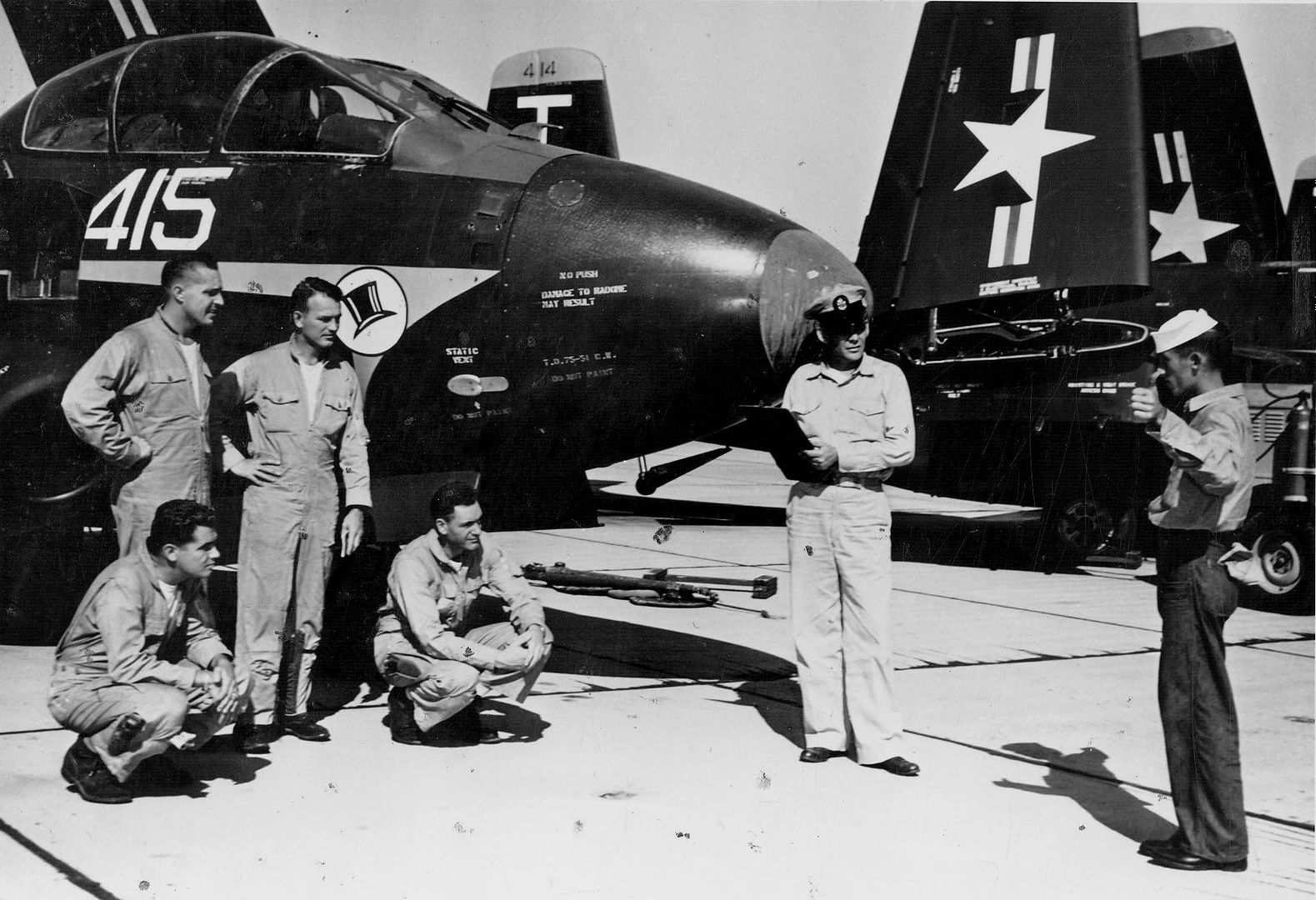

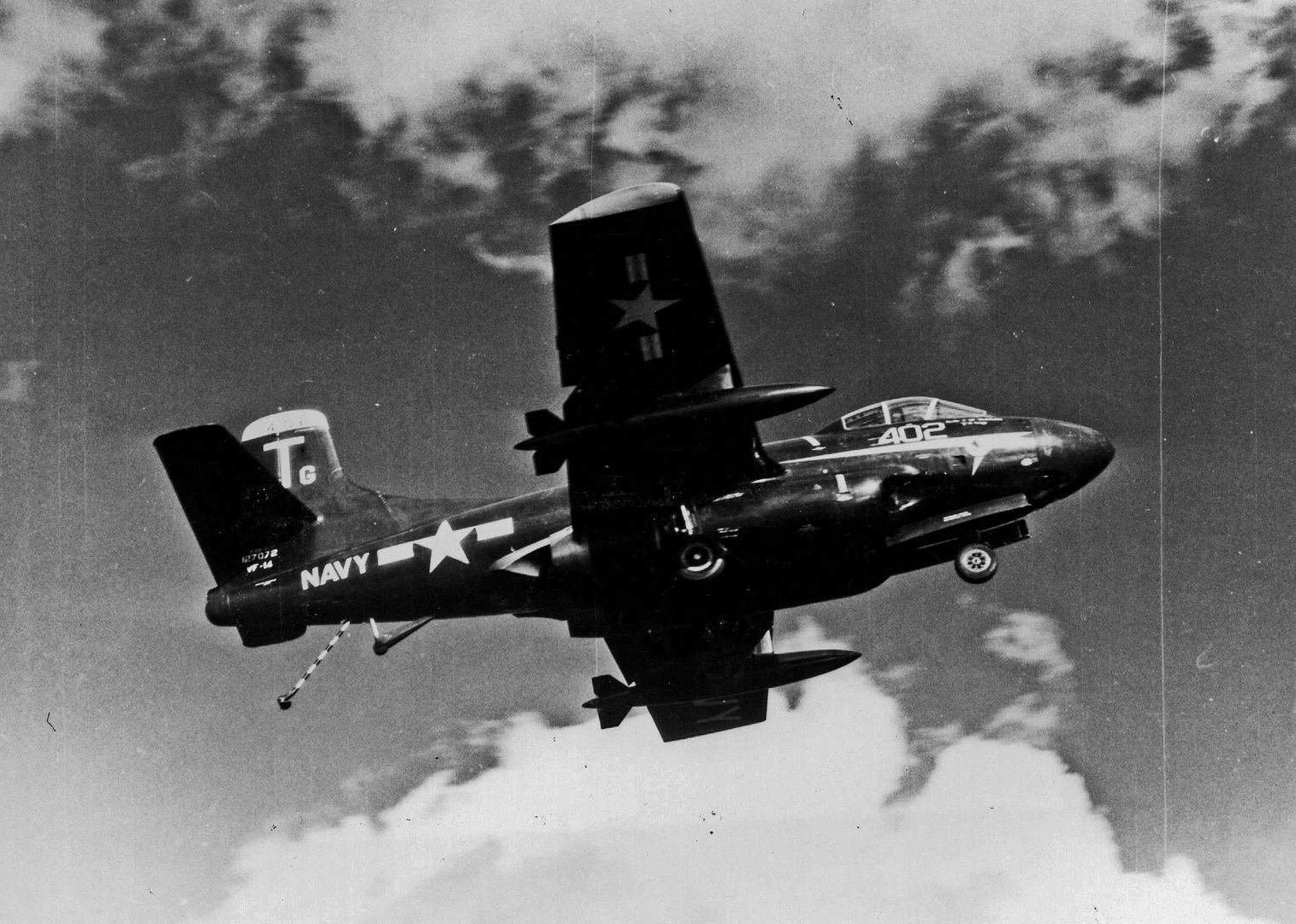
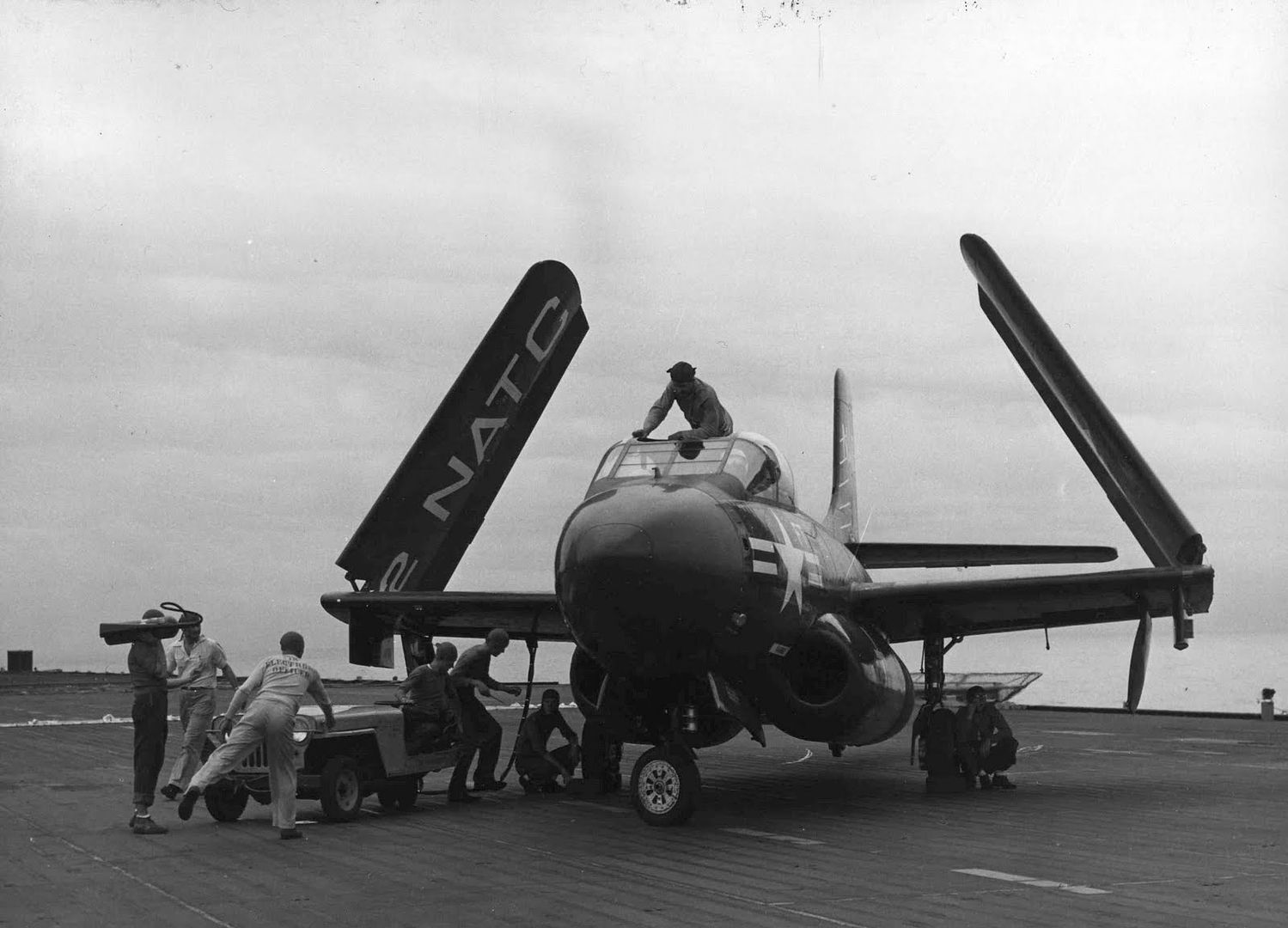
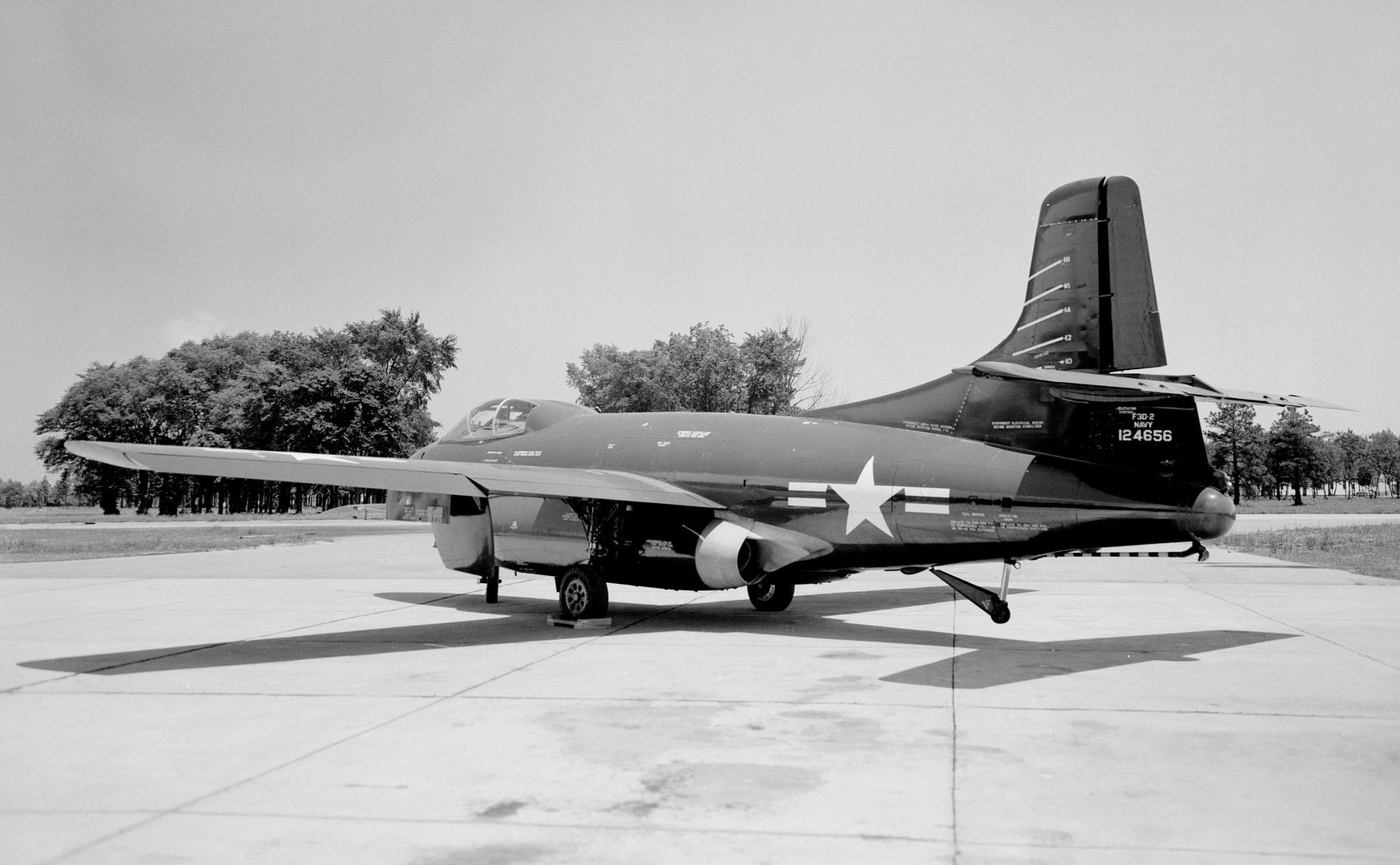
A total of 237 F3D-2s was built, with the last produced in March 1952. The Skyknight served with a number of US Navy and Marine squadrons, generally off of land bases. It was nicknamed "Willie the Whale" for its less-than-sleek appearance. Marine Squadron VMF(N)-513 was sent to Kunsan, Korea, with their Skyknights in the spring of 1952, where the type served with distinction.
The USAF had operated Boeing B-29 Superfortress heavy bombers on daylight raids over enemy territory early in the war, but suffered excessive losses to North Korean MiG-15s, and so the bombers switched to night attacks, their losses then declining considerably. However, by late 1951, the enemy had refined their ability to direct MiG-15s against the Superfortresses using ground radar control, and losses began to rise again. USAF F-94B Starfire night fighters were put into service to protect the bombers, but for various reasons they did not prove satisfactory in this role. Marine Skyknights were pressed into service as night escorts instead and performed the mission very well.
While the Skyknight was not as aerodynamically advanced as the sleek MiG-15 and did not have an excess of engine thrust by any means, its four cannon packed a hefty punch, and it could easily out-turn a MiG-15 whose pilot was foolish enough to get into a turning contest. Probably the biggest factor in the Skyknight's favor was that the MiG-15 did not have search radar, being directed to targets at night under ground radar control; in a night fight, the MiG pilot was largely blind, while the Skyknight crew could "see" perfectly well.
On the night of 2:3 November 1952, a Skyknight piloted by Marine Major William Stratton, accompanied by radar operator Master Sergeant Hans Hoagland, shot down what they reported from the exhaust pattern to be a Yak-15 fighter, and claimed a confirmed kill since the Skyknight flew through debris, narrowly evading damage. Russian records indicate the target was actually a MiG-15 -- the Yak-15 was really not suited for operational use, and wasn't used in combat in Korea or anywhere else -- and though the Skyknight set the MiG on fire, the pilot managed to extinguish the flames and get back to base. The MiG was fully operational in a few days, a tribute to its rugged construction. However, five days later, on the night of 7:8 November, another Skyknight under the command of Marine Captain Oliver R. Davis with radar operator Warrant Officer D.F. "Ding" Fessler shot down a MiG-15. Russian sources do confirm this kill and that the pilot, a Lieutenant Kovalyov, ejected safely.
On 10 December 1952, a Skyknight piloted by Marine Lieutenant Joseph Corvi with radar operator Sergeant Dan George spotted a "bogey" on radar. They could not establish visual contact, but since no "friendlies" were supposed to be in the area, they fired on the target. A kill was confirmed when Sergeant George spotted a wing tumbling past them. It turned out to be one of the little Po-2 biplanes used by the North Koreans to harass UN forces at night. The Po-2 was a difficult target, since it flew low and slow, it was small and agile, and its mostly wooden construction did not show up well on radar.
The Marine Skyknights claimed a total of at least six kills, and no B-29s under their escort were lost to enemy fighters. Two Skyknights were lost in action for unknown causes.
SKYKNIGHT MODIFICATIONS / VIETNAM
The Skyknight was clearly a first-generation jet fighter, and as such was quickly pulled out of first-line service after the Korean War, to be replaced by more sophisticated aircraft such as the Douglas F4D Skyray. However, the type was updated and converted to various alternative uses:
In 1952, some F3D-2s were given a "special armament" fit -- details are unclear -- and given the new designation "F3D-2B".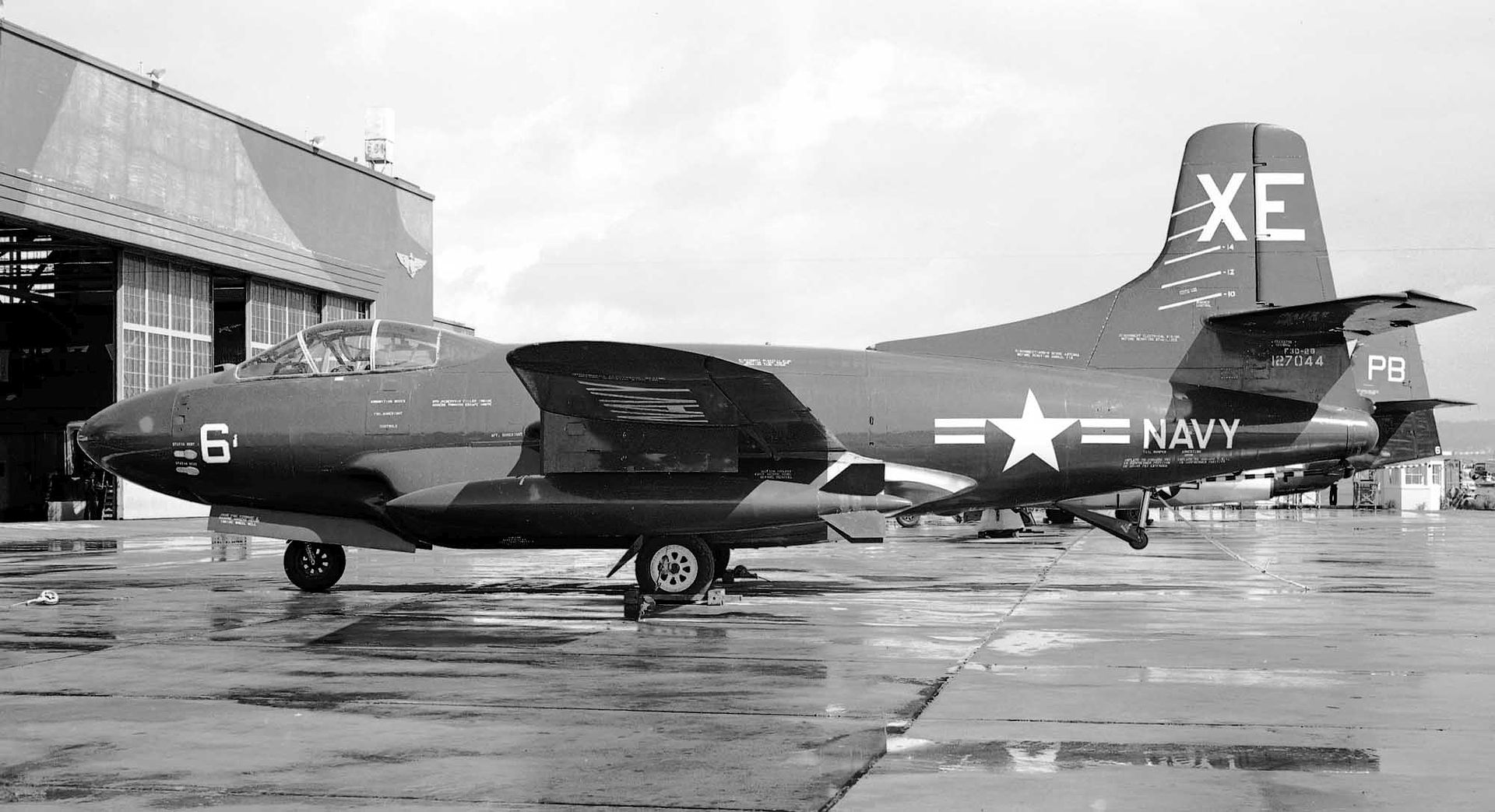
One of the three XF3D-1 prototypes was modified in late 1952 as a test aircraft for the new Sparrow I air-to-air missile (AAM), and at least twelve F3D-1s were also modified with four stores pylons under the wings to carry the Sparrow I for development testing. These F3D-1s were given the new designation "F3D-1M"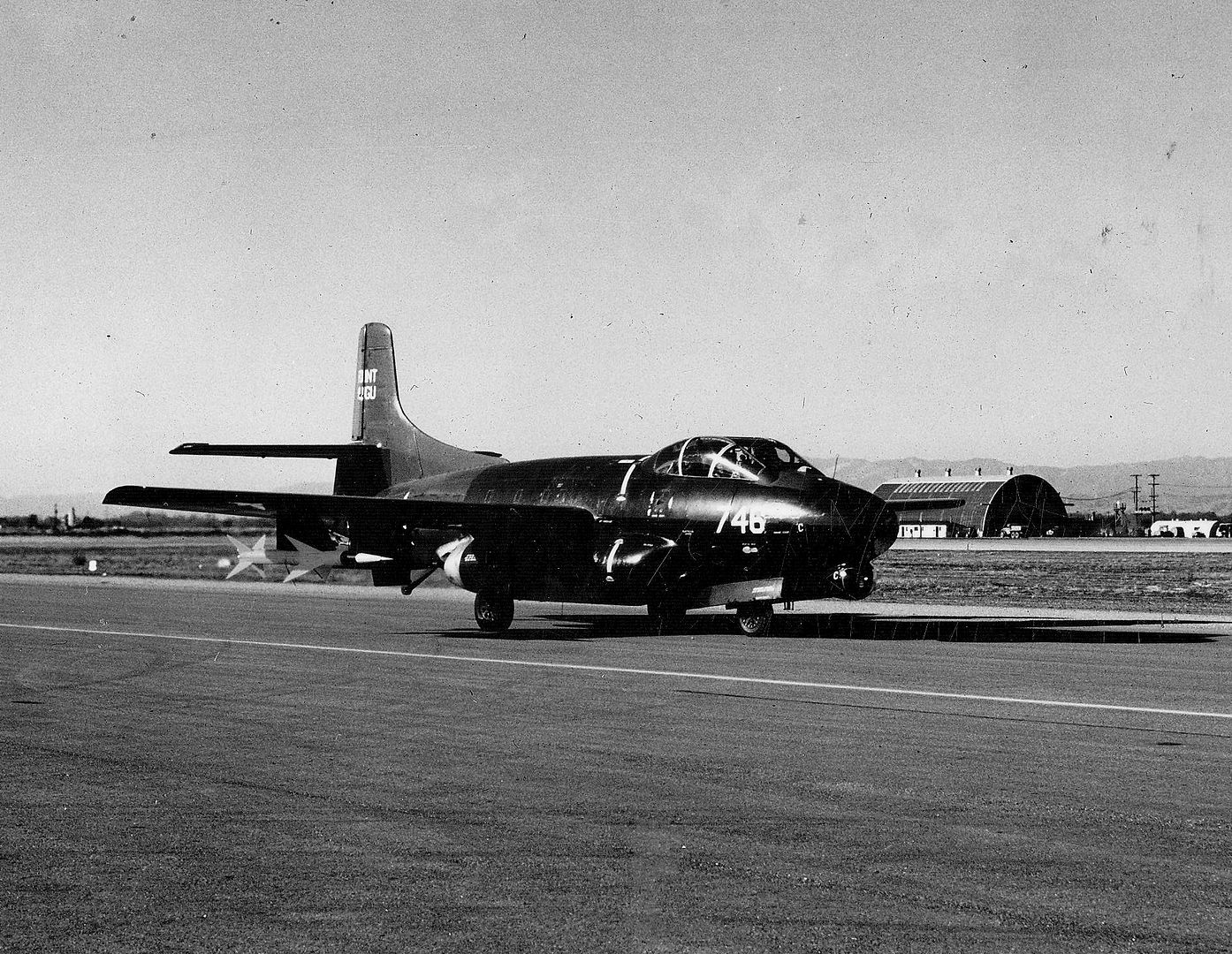
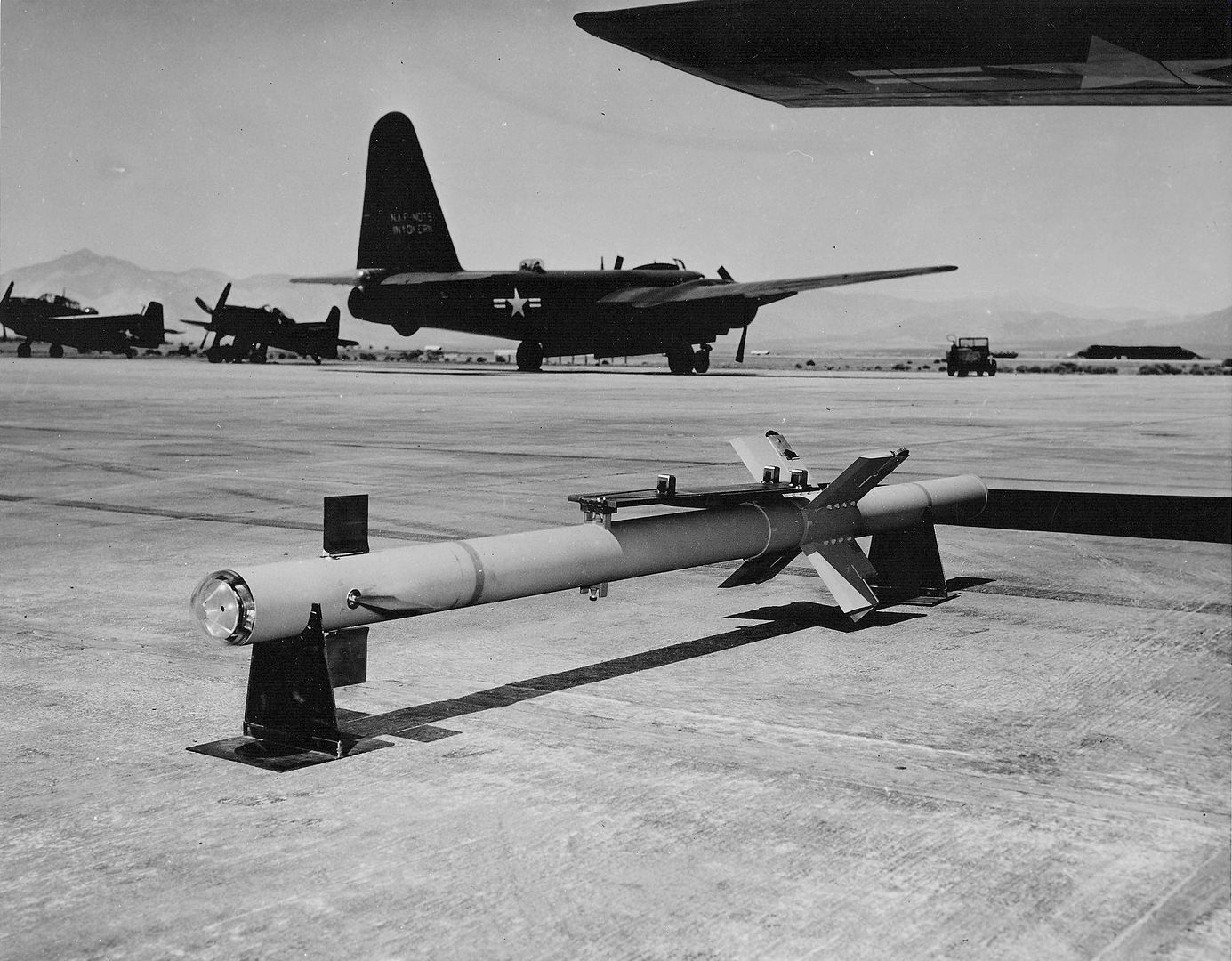
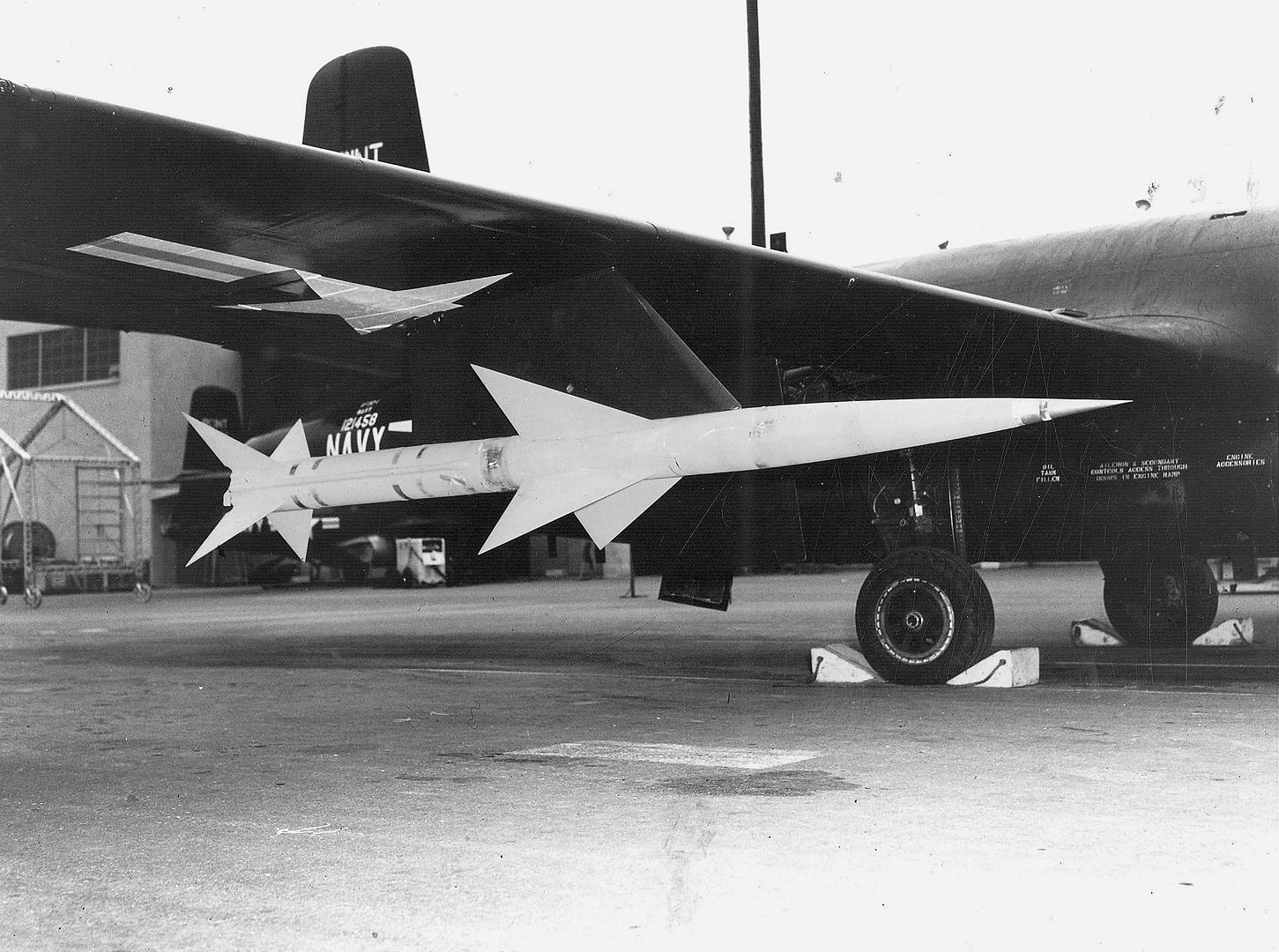



16 F3D-2s were similarly modified and redesignated "F3D-2M". Apparently the cannon were removed from Sparrow-armed Skyknights, and the aircraft were fitted with more powerful radar in a longer nose as well. It seems these were operational aircraft.
The Skyknight was also updated to trainer configurations, including five "F3D-2T" night fighter trainers and 55 "F3D-2T2" radar trainers.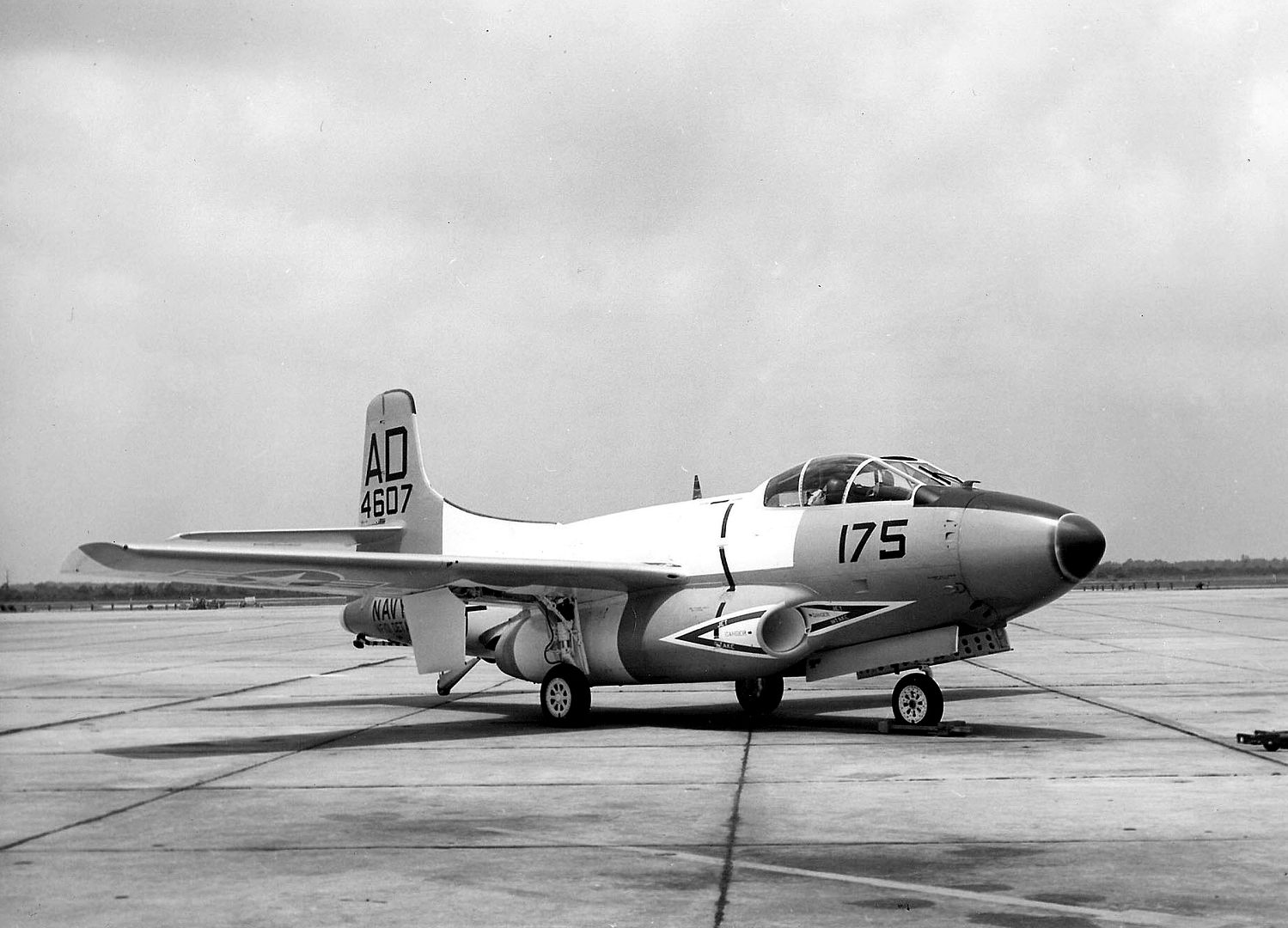
From 1956, the US Marines converted a number of Skyknights to an electronic countermeasures (ECM) and electronic intelligence (ELINT) configuration, with this variant redesignated "F3D-2Q". The radar was removed from the nose and replaced with the appropriate "black boxes", and it appears that chaff dispensers were carried as well. Some sources claim the cannon armament was removed, but some aircrew reports suggest this was not always done.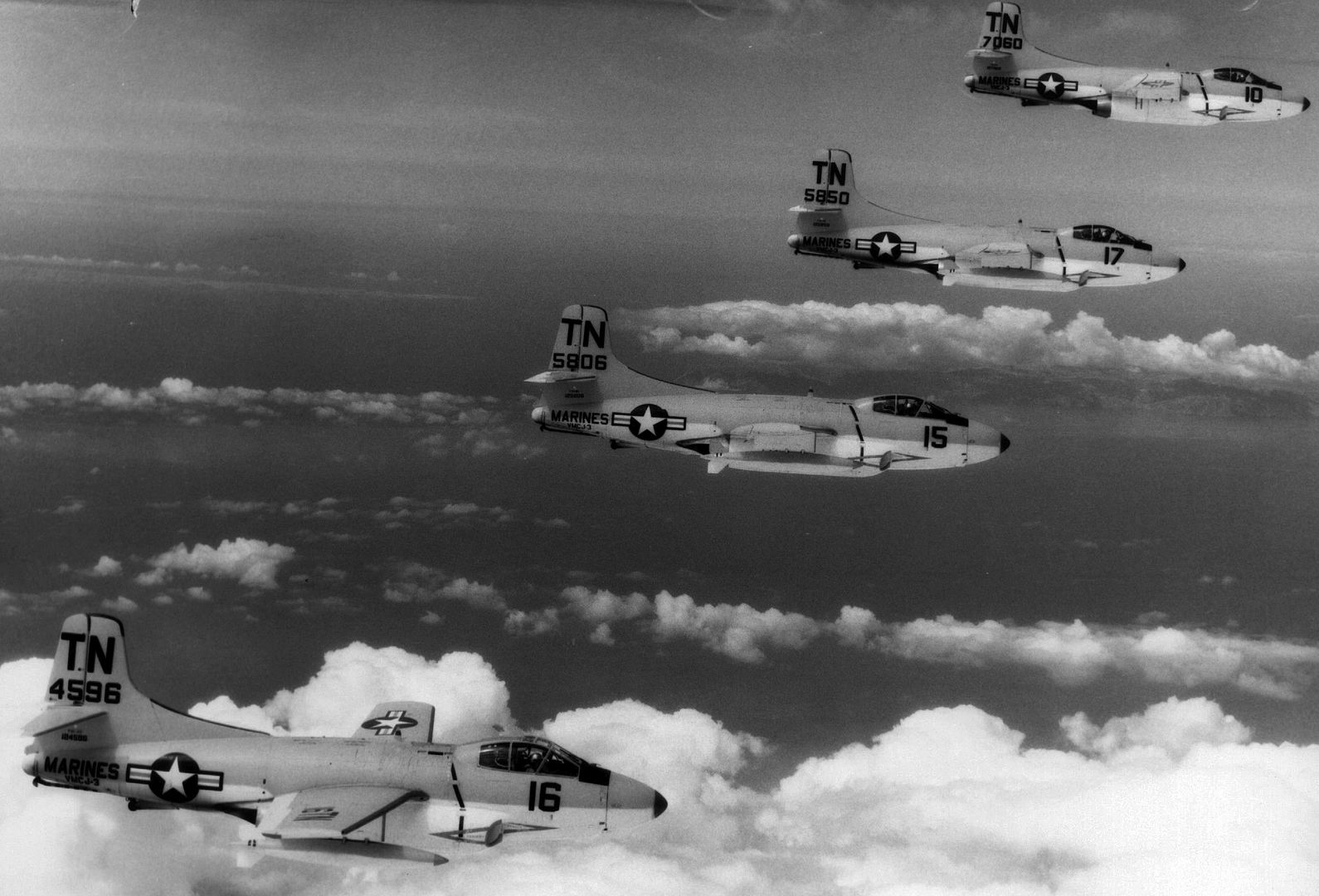
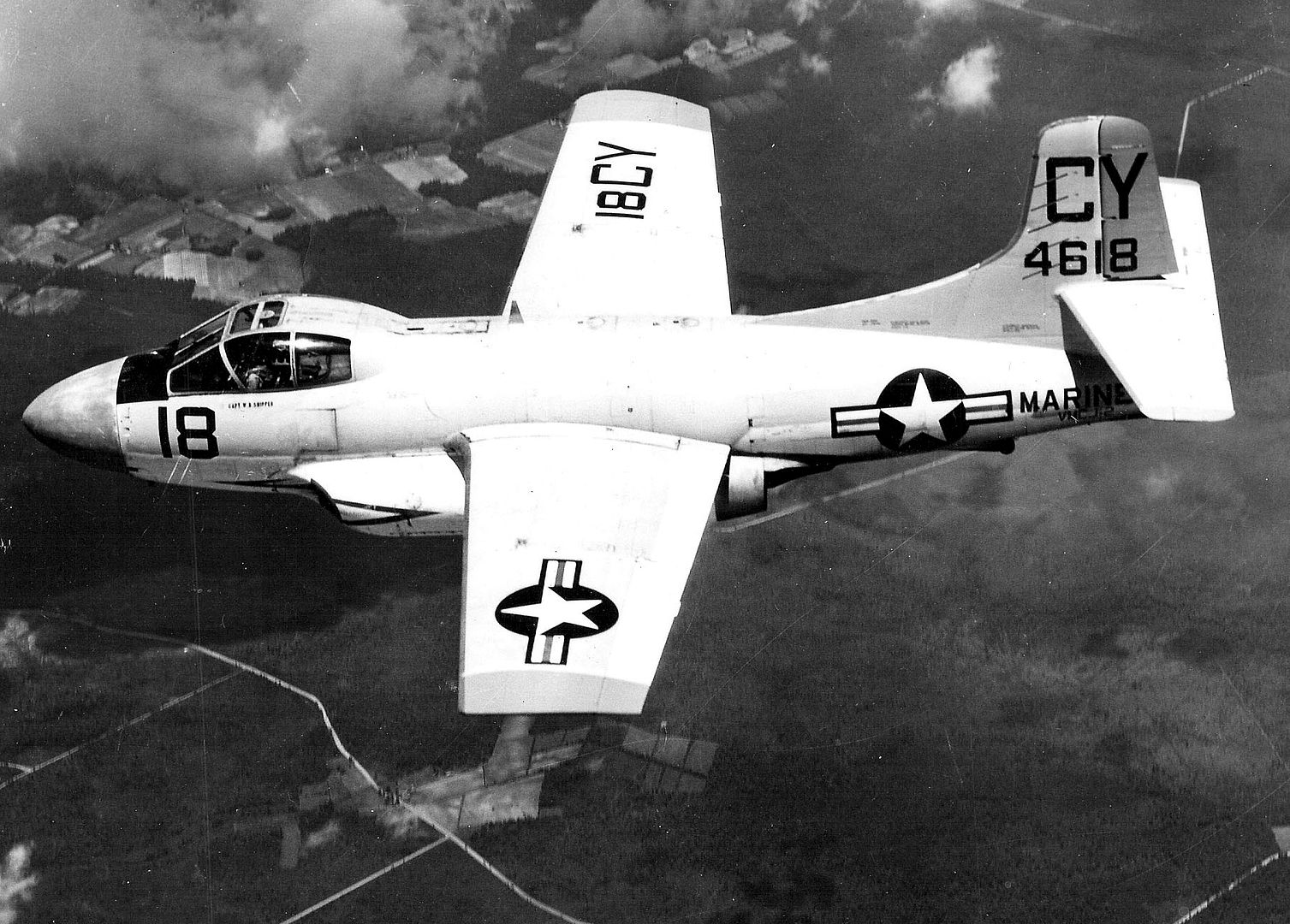
According to other reports by aircrew, the Skyknight was very well suited for use as a trials or countermeasures platform, since it had a large equipment bay in the fuselage, accessed through a door in the belly and big enough to allow a technician to stand up.
In 1962, the US military consolidated their aircraft designation schemes, and Skyknight variants still in operation were redesignated as follows:
F3D-1: F-10A
F3D-1M: MF-10A
F3D-2: F-10B
F3D-2Q: EF-10B
F3D-2T2: TF-10B
In 1965, the US began to ramp up the air war against North Vietnam, and the US military found itself short of countermeasures aircraft to protect strike packages. The EF-10B was one of the few assets on hand, and in April 1965 a handful of them were sent to Da Nang airbase in South Vietnam to support both US Navy and US Air Force raids over North Vietnam.
There were never more than about ten EF-10Bs available; they were sent on numerous "Fogbound" missions, pinning down the locations of enemy radar stations and passing off their coordinates for attack by defense-suppression aircraft, or blinding the radars with chaff and electronic jammers. Despite their age, the EF-10Bs were very effective, and they were heavily tasked well into 1966. By late 1966, Douglas RB-66 Destroyers were taking over the countermeasures role for the Air Force, with the EKA-3B Skywarrior and later the EA-6A Prowler taking over countermeasures for the Navy. However, some EF-10Bs were upgraded with new avionics in 1967, being known as "Super Whales". The Marine EF-10Bs continued to fly in Vietnam until 1969; the type was finally removed from operational service in 1970.
A number of TF-10Bs were used as test and trials platforms into the early 1980s. These aircraft were the victims of bizarre Frankenstein modifications, with noses of other aircraft such as the Douglas Skyhawk grafted on to perform tests of radar systems. No Skyknights are now in flying condition, though a number are in static display in museums and US military bases.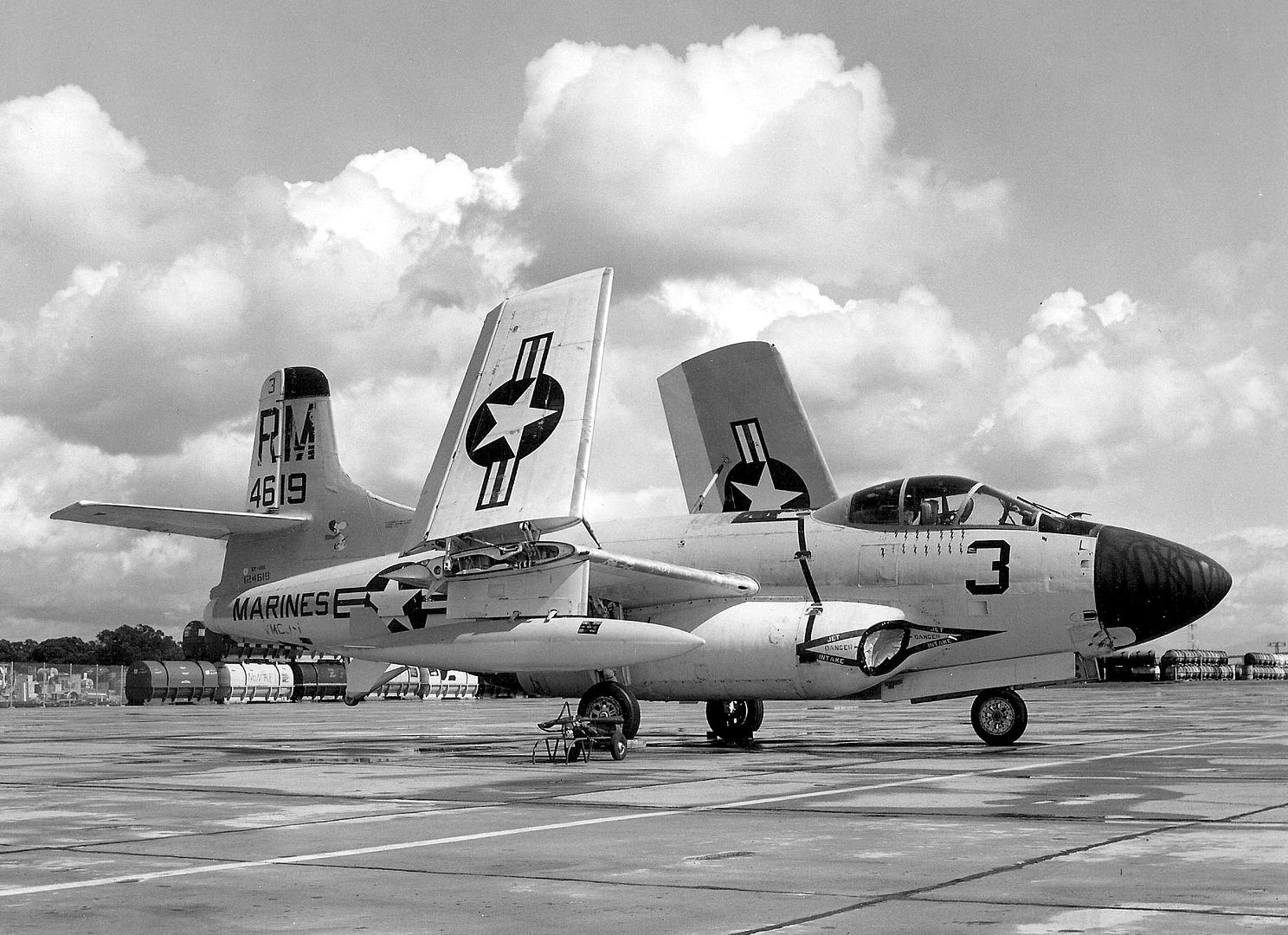
The following table gives Skyknight variants and production:
variant built mod comments
______________________________________________________________________
XF3D-1 3 Initial prototypes.
F3D-1 (F-10A) 29 Initial production with J34-WE-34 engines
F3D-2 (F-10B) 237 J34-WE-36 engines & general improvements.
F3D-2B - ? "Special armament(?)" machines.
F3D-1M (MF-10A) - 12 Sparrow-armed F3D-1 upgrades.
F3D-2M (MF-10B) - 16 Sparrow-armed F3D-2 upgrades.
F3D-2T - 5 Night-fighter trainers.
3D-2T2 (TF-10B) - 55 Radar trainers.
F3D-2Q (EF-10B) - ? Countermeasures platform.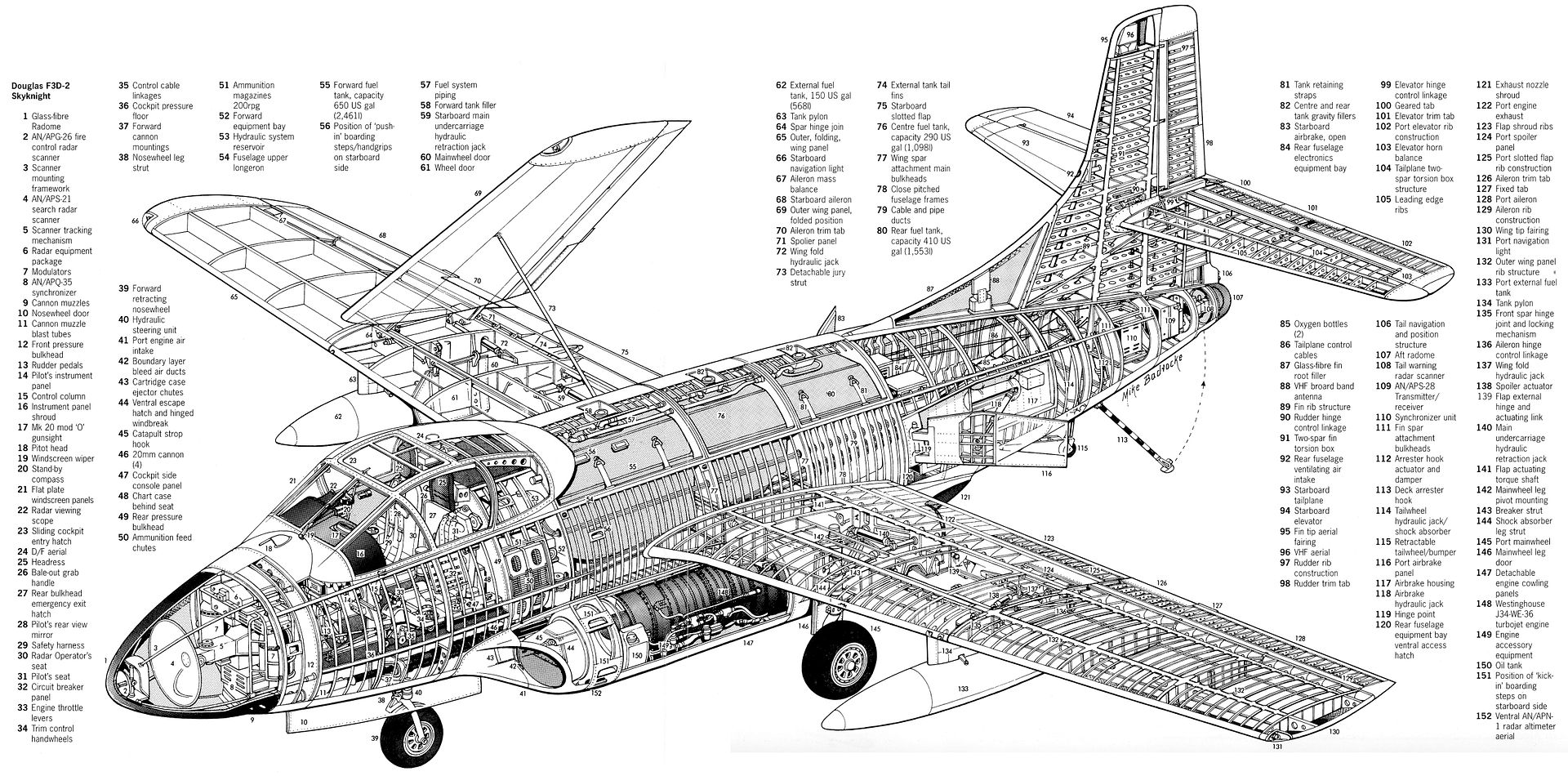
The U.S. Navy aircraft carrier USS Antietam (CVS-36) takes aboard a Douglas F3D Skyknight during testing of the Bell Automatic Landing System, in 1957. An F3D Skynight, command pilot LCdr Don Walker, landed aboard the Antietam hands-off on 12 August 1957. This landing was the first shipboard test of an automatic landing system designed to recover aircraft in all weather conditions.
Note Antietam?s radar equipment: SPS-10 (mast, right), SPS-6 (mast, left), SPS-8A (right) were up-to date radars, but the SC radar (left) and the YE homing beacon (left of SPS-8A) were outdated radars from the Second World War.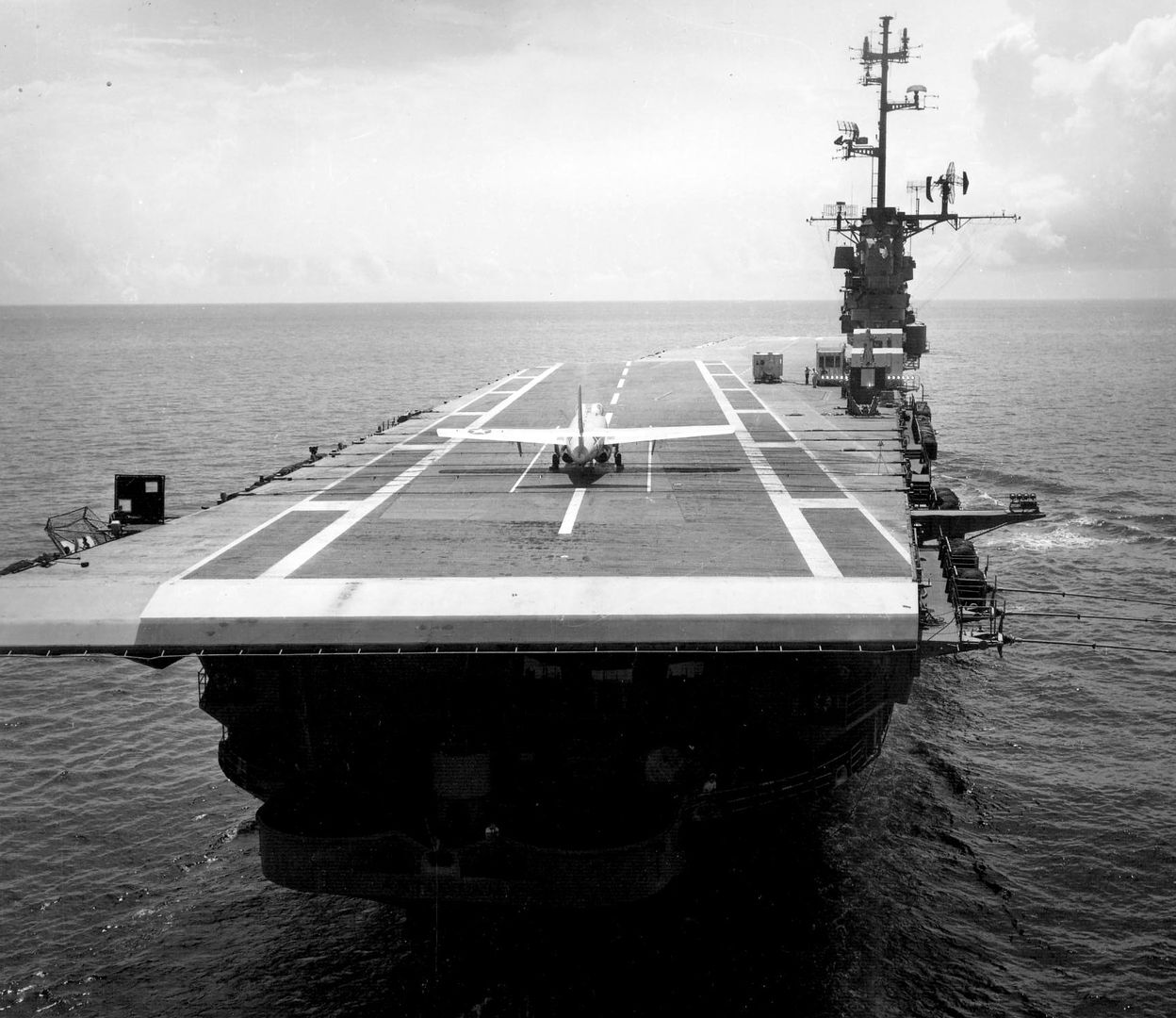
Regards Duggy
Post a reply
- Go to Previous topic
- Go to Next topic
- Go to Welcome
- Go to Introduce Yourself
- Go to General Discussion
- Go to Screenshots, Images and Videos
- Go to Off topic
- Go to Works in Progress
- Go to Skinning Tips / Tutorials
- Go to Skin Requests
- Go to IJAAF Library
- Go to Luftwaffe Library
- Go to RAF Library
- Go to USAAF / USN Library
- Go to Misc Library
- Go to The Ops Room
- Go to Made in Germany
- Go to Campaigns and Missions
- Go to Works in Progress
- Go to Juri's Air-Raid Shelter
- Go to Campaigns and Missions
- Go to Works in Progress
- Go to Skinpacks
- Go to External Projects Discussion
- Go to Books & Resources
